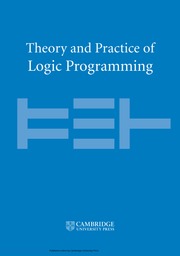Crossref Citations
This article has been cited by the following publications. This list is generated based on data provided by
Crossref.
SWIFT, TERRANCE
2014.
Incremental Tabling in Support of Knowledge Representation and Reasoning.
Theory and Practice of Logic Programming,
Vol. 14,
Issue. 4-5,
p.
553.
Riguzzi, Fabrizio
and
Swift, Terrance
2014.
Terminating Evaluation of Logic Programs with Finite Three-Valued Models.
ACM Transactions on Computational Logic,
Vol. 15,
Issue. 4,
p.
1.
Cattelani, Luca
Chesani, Federico
Palumbo, Pierpaolo
Palmerini, Luca
Bandinelli, Stefania
Becker, Clemens
and
Chiari, Lorenzo
2014.
FRAT-Up, a Rule-Based System Evaluating Fall Risk in the Elderly.
p.
38.
Grosof, Benjamin N.
Kifer, Michael
and
Fodor, Paul
2015.
Reasoning Web. Web Logic Rules.
Vol. 9203,
Issue. ,
p.
189.
Di Mauro, Nicola
Bellodi, Elena
and
Riguzzi, Fabrizio
2015.
Bandit-based Monte-Carlo structure learning of probabilistic logic programs.
Machine Learning,
Vol. 100,
Issue. 1,
p.
127.
BELLODI, ELENA
and
RIGUZZI, FABRIZIO
2015.
Structure learning of probabilistic logic programs by searching the clause space.
Theory and Practice of Logic Programming,
Vol. 15,
Issue. 2,
p.
169.
FIERENS, DAAN
VAN DEN BROECK, GUY
RENKENS, JORIS
SHTERIONOV, DIMITAR
GUTMANN, BERND
THON, INGO
JANSSENS, GERDA
and
DE RAEDT, LUC
2015.
Inference and learning in probabilistic logic programs using weighted Boolean formulas.
Theory and Practice of Logic Programming,
Vol. 15,
Issue. 3,
p.
358.
Van Ranst, Wiebe
and
Vennekens, Joost
2015.
An OpenCL implementation of a forward sampling algorithm for CP-logic.
International Journal of Approximate Reasoning,
Vol. 67,
Issue. ,
p.
60.
CALAUTTI, MARCO
GRECO, SERGIO
MOLINARO, CRISTIAN
and
TRUBITSYNA, IRINA
2016.
Using linear constraints for logic program termination analysis.
Theory and Practice of Logic Programming,
Vol. 16,
Issue. 3,
p.
353.
Riguzzi, Fabrizio
Bellodi, Elena
Lamma, Evelina
Zese, Riccardo
and
Cota, Giuseppe
2016.
Probabilistic logic programming on the web.
Software: Practice and Experience,
Vol. 46,
Issue. 10,
p.
1381.
Riguzzi, Fabrizio
2016.
The distribution semantics for normal programs with function symbols.
International Journal of Approximate Reasoning,
Vol. 77,
Issue. ,
p.
1.
Fadja, Arnaud Nguembang
and
Riguzzi, Fabrizio
2017.
Towards Integrative Machine Learning and Knowledge Extraction.
Vol. 10344,
Issue. ,
p.
89.
WIELEMAKER, JAN
RIGUZZI, FABRIZIO
KOWALSKI, ROBERT A.
LAGER, TORBJÖRN
SADRI, FARIBA
and
CALEJO, MIGUEL
2019.
Using SWISH to Realize Interactive Web-based Tutorials for Logic-based Languages.
Theory and Practice of Logic Programming,
Vol. 19,
Issue. 2,
p.
229.
Bellodi, Elena
Satoh, Ken
and
Sugiyama, Mahito
2019.
Summarizing significant subgraphs by probabilistic logic programming.
Intelligent Data Analysis,
Vol. 23,
Issue. 6,
p.
1299.
Cattelani, Luca
Chesani, Federico
Palmerini, Luca
Palumbo, Pierpaolo
Chiari, Lorenzo
and
Bandinelli, Stefania
2020.
A rule-based framework for risk assessment in the health domain.
International Journal of Approximate Reasoning,
Vol. 119,
Issue. ,
p.
242.
BELLODI, ELENA
ALBERTI, MARCO
RIGUZZI, FABRIZIO
and
ZESE, RICCARDO
2020.
MAP Inference for Probabilistic Logic Programming.
Theory and Practice of Logic Programming,
Vol. 20,
Issue. 5,
p.
641.
Azzolini, Damiano
and
Riguzzi, Fabrizio
2021.
Syntactic Requirements for Well-defined Hybrid Probabilistic Logic Programs.
Electronic Proceedings in Theoretical Computer Science,
Vol. 345,
Issue. ,
p.
14.
Riguzzi, Fabrizio
Bellodi, Elena
Zese, Riccardo
Alberti, Marco
and
Lamma, Evelina
2021.
Probabilistic inductive constraint logic.
Machine Learning,
Vol. 110,
Issue. 4,
p.
723.
Azzolini, Damiano
Bellodi, Elena
Ferilli, Stefano
Riguzzi, Fabrizio
and
Zese, Riccardo
2022.
Abduction with probabilistic logic programming under the distribution semantics.
International Journal of Approximate Reasoning,
Vol. 142,
Issue. ,
p.
41.
Vidal, Germán
2022.
Functional and Logic Programming.
Vol. 13215,
Issue. ,
p.
205.

